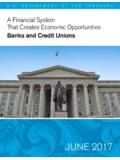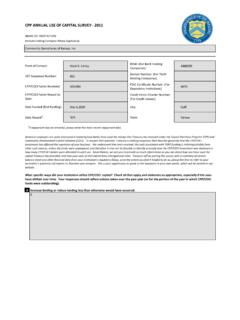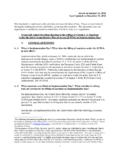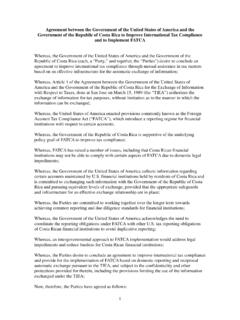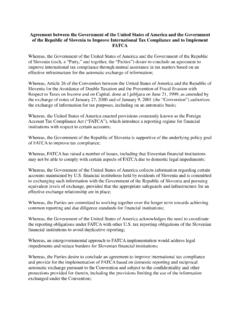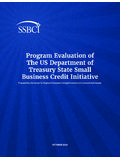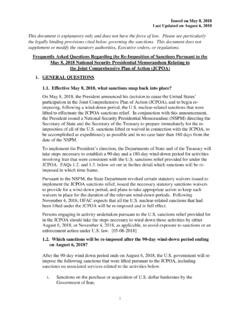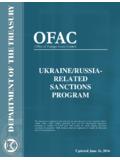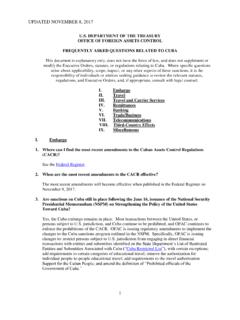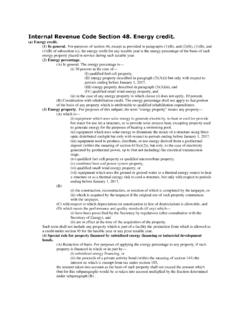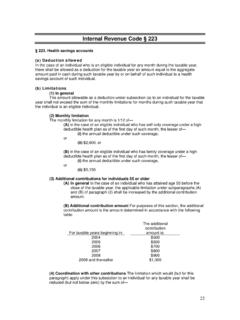Transcription of DEPARTMENT OF THE TREASURY Internal Revenue …
1 [4830-01-p] DEPARTMENT OF THE TREASURY Internal Revenue Service 26 CFR Part 1 [TD 9120] RIN 1545-BA92 Allocation and Apportionment of Expenses; Alternative Method for Determining Tax Book Value of Assets AGENCY: Internal Revenue Service (IRS), TREASURY . ACTION: Final and temporary regulation. SUMMARY: This document contains temporary regulations providing an alternative method of valuing assets for purposes of apportioning expenses under the tax book value method of The alternative tax book value method, which is elective, allows taxpayers to determine, for purposes of apportioning expenses, the tax book value of all tangible property that is subject to a depreciation deduction under section 168 by using the straight line method, conventions, and recovery periods of the alternative depreciation system under section 168(g)(2).
2 The alternative method provided in the temporary regulations is intended to minimize basis disparities between foreign and domestic assets of taxpayers that may arise when taxpayers use adjusted tax basis to value assets under the tax book value method of expense apportionment. The text of these temporary regulations also serves as the text of the proposed regulations set forth in the Proposed Rules section of this issue of the Federal Register. 2 DATES: Effective Date: These regulations are effective on March 26, 2004. Applicability Date: For dates of applicability, see (h)(5)(iii) and (i)(3).
3 FOR FURTHER INFORMATION CONTACT: Margaret A. Hogan, (202) 622-3850 (not a toll-free number). SUPPLEMENTARY INFORMATION: Background This document contains amendments to regulations under section 864(e) of the Internal Revenue code ( code ). section 864(e) was enacted by the Tax Reform Act of 1986 (Public Law 99-514, 100 Stat. 2121) to address concerns regarding the allocation and apportionment of interest expense. On September 14, 1988, the IRS published temporary regulations ( 8228, 1988-2 136 [53 FR 35467]) under implementing section 864(e) of the code . The temporary regulations contained in this document amend and make conforming amendments to and (g)(1)(ii).
4 section 864(e)(2) of the code provides that allocations and apportionments of interest expense shall be made on the basis of assets rather than gross income. For this purpose, the regulations permit a taxpayer to choose to compute the value of its assets under either the tax book value method or the fair market value method. Sections (c)(2) and (g)(1)(ii). Taxpayers using the tax book value method may elect to change to the fair market value method at any time. Rev. Proc. 2003-37, 2003-1 950 (May 27, 2003). Taxpayers that elect to use the fair market value method must continue to use that method unless expressly authorized by the 3 Commissioner to change methods.
5 section (c)(2). section (c)(2) also permits taxpayers to apportion certain other expenses based on the comparative value of assets provided that such apportionment is made in accordance with the rules of (g). The use of adjusted tax basis for purposes of apportioning expenses under the tax book value method may result in disparities between the bases of domestic and foreign assets of a taxpayer because of the differences in depreciation methods applicable to those assets. For example, the tax book value of tangible property used in the United States generally reflects depreciation of that property pursuant to the modified accelerated cost recovery system (MACRS) under section 168.
6 MACRS generally permits a taxpayer to depreciate tangible property (other than real property) under the 200-percent declining balance method, or the 150-percent declining balance method in the case of certain property. section 168(b). MACRS also permits taxpayers to depreciate property over shorter recovery periods than a property s class life. In contrast, tangible property used predominantly outside the United States generally must be depreciated pursuant to the alternative depreciation system (ADS) under section 168(g). section 168(g)(1)(A). ADS requires a taxpayer to depreciate tangible property using the straight line method of depreciation.
7 Additionally, ADS generally requires taxpayers to use recovery periods equal to the property s class life and therefore longer periods than those used under MACRS. As a result of accelerated depreciation under MACRS as compared to slower depreciation under ADS, an asset used in the United States generally will have a lower adjusted tax basis ( , tax book value) than if the same asset were used predominantly 4outside of the United States. The relatively higher tax book value for assets used predominantly outside the United States results in an increased apportionment of interest expense to foreign source income and a corresponding reduction in the taxpayer s foreign tax credit limitation.
8 A disparity in the apportionment of expenses between domestic and foreign assets also may result when a corporation owns a 10-percent or greater interest in a foreign subsidiary that holds tangible property. section 864(e)(4) provides that for purposes of allocating and apportioning expenses on the basis of assets, the tax basis of stock in a nonaffiliated 10-percent owned corporation will be adjusted to reflect the earnings and profits of the corporation that are attributable to the stock held by the taxpayer. See also (c)(2). Accordingly, the adjusted tax basis of stock in a foreign corporation for purposes of apportioning expenses generally will reflect the foreign corporation s earnings and profits, the computation of which reflects the depreciation of tangible property.
9 Under section 312(k), tangible property generally is depreciated under ADS for purposes of determining earnings and profits. Accordingly, a taxpayer that owns a 10-percent or greater interest in a foreign corporation that holds tangible property may be subject to a disparity similar to the one that arises where the taxpayer holds foreign assets directly. Explanation of Provisions The temporary regulations provide an alternative method of determining the tax book value of assets (the alternative tax book value method ). The alternative tax book value method allows a taxpayer to elect to determine the tax book value of its tangible property that is subject to depreciation under section 168 as though all such property 5had been depreciated using ADS under section 168(g)(2) during the entire period in which it has been in service.
10 The temporary regulations further provide that tax book value will be determined without regard to the election to expense certain depreciable assets under section 179. Because tax book value will be computed under ADS, the rules permitting a special allowance for property acquired after September 10, 2001, and before January 1, 2005, will not apply. See section 168(k)(2)(C)(ii). Application of section 168(g)(2) as prescribed by these temporary regulations applies solely for determining an asset s tax book value for purposes of apportioning expenses (including the calculation of the alternative minimum tax foreign tax credit pursuant to section 59(a)) under the asset method described in (g).
